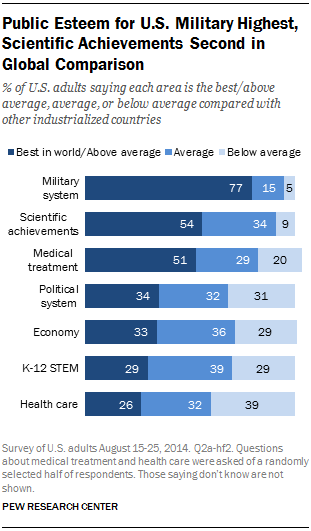
Science holds an esteemed place in the public imagination and in the minds of professionals. Americans are proud of the accomplishments of their scientists in key fields and, despite considerable dispute about the role of government in other realms, there is broad public support for government investment in scientific research.
At the same time, scientists and citizens are critical of the K-12 education system when it comes to the quality of teaching about science, technology, engineering, and math (called STEM subjects). Scientists are also pessimistic about the state of funding for their research, even as the public largely supports it.
This chapter covers the core findings about the overall place of science as found in the Pew Research survey of the general population and that of a representative group of scientists who belong to the American Association for the Advancement of Science.
The Public Image of the U.S. as a Global Leader in Key Sectors
In the survey, we wanted to understand the public’s views about science in the context of other key American institutions and industries, including some outside the realm of science and technology. A mixed picture emerges in people’s responses as they generally value U.S. scientific achievements but are critical about the state of science and math education to primary and secondary school students.
Overall, 54% of adults consider U.S. scientific achievements to be either the best in the world (15%) or above average (39%) compared with other industrial countries. In this question series, the only aspect of American society rated more favorably is the U.S. military system, with 77% of adults saying the U.S. military is the best in the world or above average.
The public’s views of how the education system is teaching science, technology, engineering, and math (called STEM) to K-12 students is considerably less glowing. About three-in-ten (29%) adults consider U.S. STEM education for grades K-12 to be above average or better compared with other industrialized countries, another 39% say it is average and 29% say it is below average.11
Public assessments of the U.S. medical system vary strongly, depending on the focus of the question. Half of the survey respondents were asked to rate “U.S. medical treatment” while the other half were asked about “U.S. health care.” Americans’ views of “medical treatment” in the U.S. were considerably more positive than their views of “health care.” Some 51% of those asked about medical treatments rated it the best in the world or above average. On the other hand, only 26% said U.S. “health care” was the best or above average. These differences likely arise from different connotations associated with each term. Those assessing “treatments” might have been thinking about medical advances in fighting diseases and creating medical devices and felt the science community is making notable progress. On the other hand, those asked about “health care” might have been making a broader assessment about the system of providing health care in America, the subject of considerable public dispute in recent years.
Public assessments of the U.S. political system and the economy are mixed. Fully 34% of adults say the U.S. political system is the best or above average, another 32% say it is average and 31% say it is below average compared with other industrialized countries. Similarly, a third (33%) of adults say the U.S. economy is the best or above average, 36% say it is average and 29% say is below average.
Changes in Public Image of U.S. Institutions
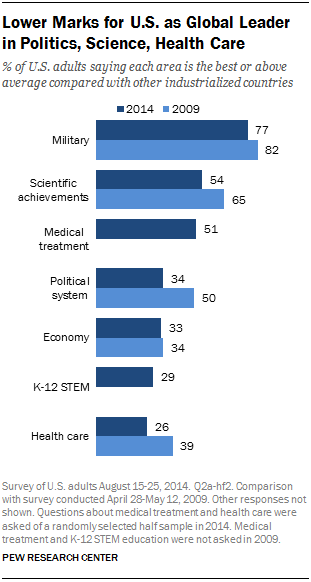
Americans’ views about the relative rank order of the topmost institutions is about the same as it was in 2009, when Pew Research last asked the public to rate sectors in this way. But, the public is less enthusiastic about the standing of the U.S. compared with other industrialized countries in several areas including the political system, scientific achievements, and health care.
Public esteem for the military is down modestly from 2009 although most Americans still hold the military in high regard. Fully 77% of adults say the military is among the best or better than average compared with other industrialized countries, down from 82% in 2009.
Scientific achievements, while also seen in largely positive terms, are down 11 points from 65% in 2009 to 54% today saying U.S. scientific achievements are the best or above average compared with other industrialized countries. More now see U.S. scientific achievements as “average” in global comparisons (up from 26% in 2009 to 34% today) or “below average” (up slightly from 5% in 2009 to 9% today).
The public’s still-positive ratings of U.S. scientific achievements are followed closely by those for medical treatments with 51% saying it is the best in the world or above average. (The 2009 survey did not ask about medical treatment.)
By contrast, just 26% of adults today say that U.S. “health care” is above average or the best in the world, down 13 points from 39% in 2009.12 Political differences explain much of this change. In 2009, Republicans and independents who lean to the Republican Party were much more inclined than their Democratic counterparts to see the U.S. health care system in a positive light (55% vs. 28% of each group, respectively, said it was the best in the world or above average). But Republicans’ opinions about the place of U.S. health care in a global context have dropped sharply since 2009, while views among Democrats’ have dropped a more modest 6 points. These partisan differences are likely related to the debate over the Affordable Care Act, also called “Obamacare,” during the same period. As a result, both groups now hold roughly similar views of how U.S. health care stacks up in a global context.
Perceptions of the U.S. political system have also dropped over the same time period. Yet, unlike perceptions of health care, people’s views about the political system are not associated with party affiliation. Today, 34% of adults say the U.S. political system is the best in the world or above average compared with other industrialized countries, down 16 points from 50% in 2009. Partisan groups hold similar views about the political system, as was also the case in 2009.
People’s perceptions of the U.S. economy in global comparison have held steady. A third of adults (33%) says the U.S. economy is the best or above average relative to other industrialized countries, roughly the same as in 2009 (34%).
Patterns Among the General Public
There were some modest demographic differences among respondents in assessing U.S. scientific achievements today. Men are more likely than women (60% vs. 48%) to consider U.S. scientific achievements to be at least above average compared with other nations. Those with a college degree tend to give higher marks to U.S. scientific achievements (as well as several other domains) than do those with less formal education. But, those with a degree in a science field do not differ from other college graduates in their views about U.S. scientific achievements. And, there are no significant differences on this rating by age or political orientation.
There are no or only modest differences in assessments of K-12 STEM education by gender, age, or political leanings. But unlike ratings of U.S. scientific achievements, education is inversely related to ratings of STEM education for grades K through 12: 35% of college graduates say K-12 STEM is below average compared with other nations while 23% of those with no more than a high school diploma say the same.
Comparing Public and AAAS Scientists’ Views
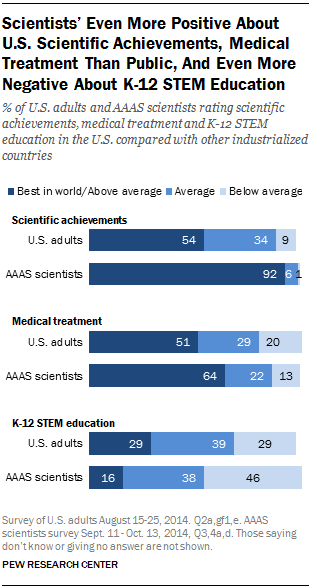
Scientists are far more positive about the country’s scientific achievements and its medical treatments than the general public. But, scientists are also more downcast about K-12 STEM education than the public.
Fully nine-in-ten (92%) AAAS scientists say scientific achievements in the U.S. are the best in the world (45%) or above average (47%). In 2009, 94% of scientists said the same. Scientists are also positive about the global standing of U.S. medical treatment; nearly two-thirds of scientists (64%) consider U.S. medical treatment to be above average or better than other industrialized countries. About half of the general public (51%) says the same.
But both AAAS scientists and the general public are markedly less positive about K-12 STEM education – and the scientists are the most critical. Just 16% of scientists and 29% of the general public say that U.S. STEM for grades K-12 is above average or the best in the world.
Scientists are Less Upbeat Than They Used To Be
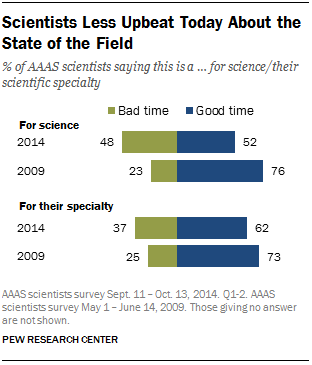
Despite their overall positive views, scientists are more downbeat about the general state of science compared with five years ago. Today, 52% of AAAS scientists say this is good time for science, down from 76% in 2009.
Scientists tend to be more positive, by comparison, when it comes to the state of their scientific specialty. Yet, here too, scientists today are less rosy in their assessments than in our previous survey. Some 62% of AAAS scientists say this is a good time for their specialty area, down 11 percentage points from 2009.
The drop since 2009 in views about the state of science occurred among AAAS scientists of all disciplines, those with a basic and applied research focus, and among those working in industry and those in academia. For more on scientists’ assessments of science and technology today and in comparison with other industrialized nations, see Chapter 4.
Effects of Science on Society
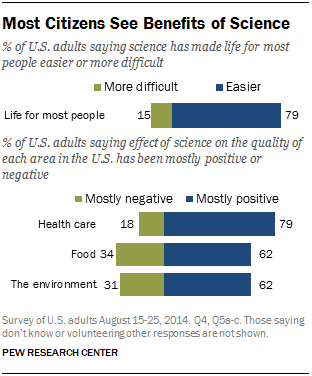
The general public tends to see the role of science in society positively. About eight-in-ten adults (79%) say that science has made life easier for most people while just 15% say it has made life more difficult. The balance of positive to negative views is a bit less rosy today than in 2009 when 83% said that science had made life easier and 10% said it made life more difficult.
Further, a majority of adults say that the effect of science has been positive when it comes to the quality of three specific aspects of life. Fully 79% say science has been a positive force in the quality of U.S. health care; 62% say science’s impact on food is positive; and, 62% say the same thing about the impact of science on the environment.
These positive public views about the effect of science in each domain are down modestly from 2009 for health care (6 percentage points lower), for food quality (4 percentage points lower) and for the quality of the environment (4 percentage points lower). The corresponding uptick in negative views is a bit larger (8 to 10 percentage points) because more expressed a judgment on these issues in 2014 than did so in 2009. Thus, the balance of public views is somewhat less positive today than in 2009 for all three areas.
Patterns Among the General Public
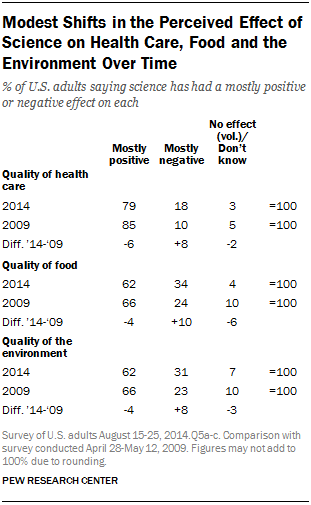
Any differences in assessments of the effect of science overall or across these domains by gender, age, education or political leanings tend to be modest. Adults under age 50 are more positive about the effects of science on life for most people and about the effect of science on health care than are those ages 50 and older. But, both age groups have about the same views when it comes to the effect of science on the quality of food and the environment. And, college graduates are more positive than those with less education on three of these four assessments.
Despite increased political differences on assessments of climate change in recent years, two-thirds (66%) of Republicans and independents who lean toward the Republican Party say that the effect of science on the quality of the environment in the U.S. has been mostly positive, as do 61% of Democrats and independents who lean toward the Democratic Party. (A detailed analysis of the differences and similarities among those with different political views about science and technology topics will be issued later this year.)
Funding for Research
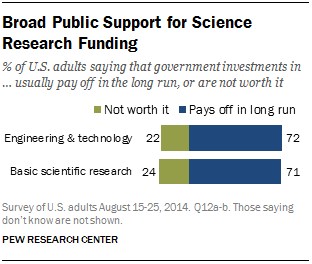
A solid majority of the public expresses support for government funding for science and technology. About seven-in-ten adults say that government investments in engineering and technology (72%) and in basic scientific research (71%) usually pay off in the long run. While support for funding is about the same as in 2009, negative views that each type of funding is “not worth it” have edged up (5 percentage points for engineering and technology and 6 points for basic science research).
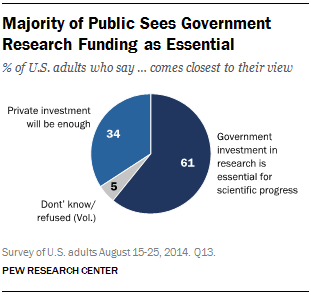
A majority of the public considers government funding critical to the scientific enterprise. Fully 61% say that government investment is essential for scientific progress while 34% say that “private investment will ensure that enough scientific progress is made, even without government investment” in research. A similar share in 2009 said that government investment was essential (60%) and a slightly smaller share, 29%, said private investment would be enough to ensure progress.
Patterns Among the General Public
Support for government funding of research tends to be widespread across the demographic spectrum. Fully 74% of women and 68% of men say that government funding of basic science pays off in the long run; men and women are about equally likely to say that government funding of engineering pays off in the long run (72% each). College graduates tend to express more support for research funding than do those with less formal education. Similarly, younger generations are a bit more likely than older ones to say research funding pays off in the long run, but a majority of all age groups say that government funding of both basic science and engineering research pays off in the long run.
Scientists’ Views about Funding
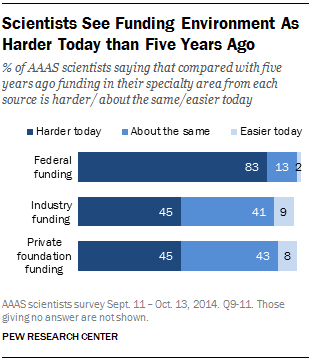
[its]
Fully 83% of AAAS scientists say that getting government funding in their specialty area is harder today than it was five years ago, just 2% say getting federal funding is easier today and 13% say it is about the same. Some 45% of AAAS scientists also say it is harder to get research funding from industry sources or from private foundations today compared with five years ago.
Further, when asked to consider whether each of seven potential issues is a “serious problem for conducting high quality scientific research today” only one was selected by a majority of scientists: lack of funding for basic research. Some 88% of AAAS scientists report that lack of research funding hinders research today.
A majority of AAAS scientists identity funding as a serious problem for conducting research today, regardless of discipline, employment setting, or a basic or applied research focus in their own research.
For more on AAAS scientists’ views about funding, problems for conducting research and other issues in science today, see Chapter 4.




